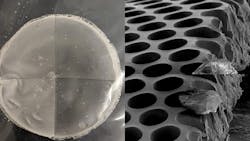Water Treatment: Membranes Deliver Purification Portability
Two researchers at Pennsylvania State University (Penn State), State College, Penn., have won a $570,000 grant to develop a portable, lightweight and easy-to-operate water purification unit for field use by both marines and first responders.
The grant, from the Office of Naval Research (ONR), Arlington, Va., provides three years’ funding for a team headed by associate professor of chemical engineering Chris Arges and associate professor of civil and environmental engineering Christopher Gorski to investigate membrane capacitive deionization (MCDI) in water purification.
“Although the bulk of global desalination utilizes a process known as reverse osmosis at centralized production facilities, it is not suitable for military teams, as it requires high-pressure piping and hardware and is difficult to operate in the field,” Arges says. “MCDI, on the other hand, is effective, mobile and energy efficient.”
MCDI uses ion exchange membranes and porous electrode technology in an electrosorption process to separate ions such as sodium and chloride from water, leaving it drinkable. Solar or battery power allows portability.
Electrodes, when they become saturated with salt, can be regenerated by slowing down the water flow and swapping the cell’s polarity. While this uses up some of the cleaned water, it also produces electrical energy that can be recovered and reused in the next desalination cycle.
One of the challenges for Arges and his team is to improve MCDI’s function with saltier water sources. The plan is to redesign the electrochemical cell module and use etching and lithographic technology developed by Penn State’s Nanofabrication Lab to fabricate an interlocking pattern of microscopic wells on the membrane surface. This, in turn, increases the interfacial area between the membrane and electrodes, improving contact and reducing the distance that sodium and chloride ions travel to cross the membrane/electrode interface, while also allowing the electrode material to store more of both ions.
If this works, the purification unit will run for longer periods between regenerations.
The team believes if the improved MCDI unit performs successfully, it could be used to purify seawater as well as ground and brackish water.
“[Because] the proposed approach for this grant has worked for us in the past, we believe the increased interfacial area will reduce ionic transport resistance, leading to cleaner water in greater quantities,” notes Arges, referencing an earlier project that used similar bipolar membrane (BPM) patterning technology to make oxygen and hydrogen in an electrolysis cell.
Described in a 2021 issue of Journal of Materials Chemistry A, the team focused on the design of the polycation/polyanion interface as a likely place to improve BPM performance. While other research efforts concentrated on water dissociation catalysts to achieve this, the Penn State team’s soft lithography fabricated a series of micropatterned BPMs with precise control over the interfacial area in the bipolar junction.
The researchers made several important findings. First, a relationship exists between an increase in interfacial area and a reduction in the onset potential. Second, that same increase yields marginal improvements in the current density due to the junction region being under kinetics-diffusion control. Finally, they found that the soft lithography approach also was conducive for fabricating BPMs with different chemistries ranging from perfluorinated polymer backbones to alkaline stable poly(arylene) hydrocarbon polymers — some of which performed better than commercially available versions.
For its part, the ONR long has been working to develop easy-to-carry water purifiers both for deployed marines and first-responders in remote areas.
In Spring 2013 during a military exercise, the organization successfully tested a new prototype purifier that used ultrafiltration membranes and chlorine addition to make safe water from all freshwater sources, including surface waters with large amounts of algae and cloudiness caused by sediment. The purifier came in two versions: one that treated 1,000 gal/day, and the other 5,000 gal/day.
Developed through a collaboration with Pacific Research Group, Newport Beach, Calif., and Global Water, Arlington, Va., the easy-to-operate purifier was light and compact enough to be carried by just two marines and could fit in the back of a pickup truck. It also required less maintenance and power than current systems, which can involve repeated resupply of parts, trained operators and major power sources — all unavailable during typical disaster-relief scenarios.
Since then, the three organizations worked together to design and test water-treatment technologies that complement the original purifiers. Newer prototypes include an optional reverse osmosis capability for brackish water that would accommodate most surface water sources anywhere in the world.
Seán Ottewell is Chemical Processing's editor at large. You can email him at [email protected].

